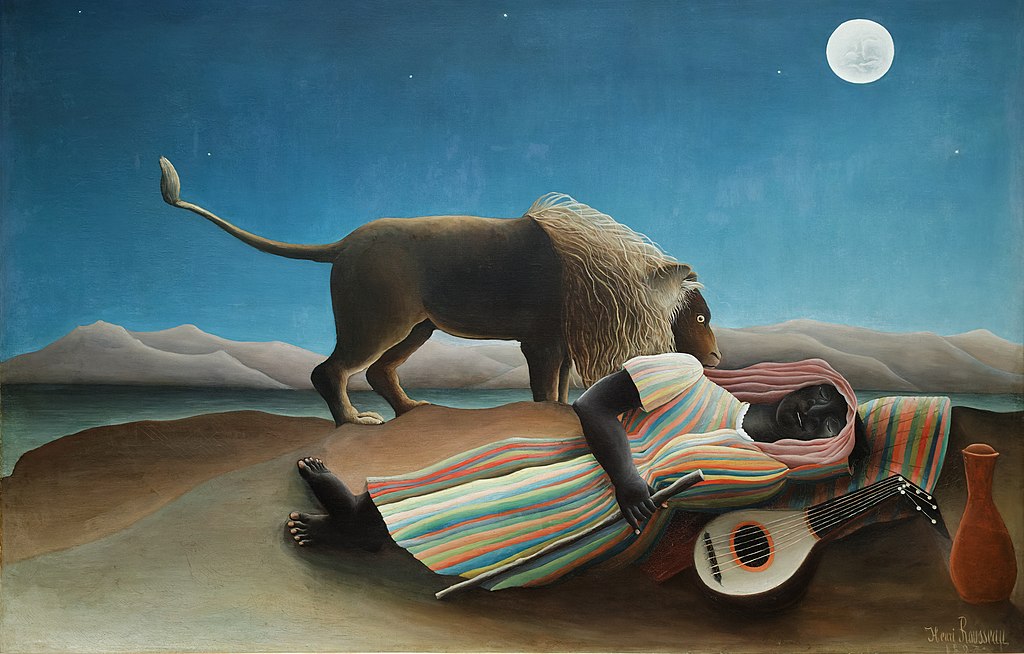
The Sleeping Gypsy: A Captivating Dream Amidst the Desert Sands
Introduction
“The Sleeping Gypsy” is a mesmerizing and enigmatic painting created by French artist Henri Rousseau in 1897. This iconic work of art is an excellent representation of the Post-Impressionist and Naïve art movements, showcasing Rousseau’s unique style and imaginative storytelling. The painting has captivated art enthusiasts and critics alike for its dreamlike quality, symbolic elements, and emotional depth.
The Artwork
“The Sleeping Gypsy” depicts a mysterious and poetic scene set in the vastness of a desert landscape beneath a clear night sky. In the foreground, a serene gypsy woman is depicted sleeping soundly on the sandy ground, her body draped in colorful fabric. A mandolin lies nearby, suggesting she might be a traveling musician. Her face radiates tranquility, while her rosy cheeks and deep slumber imply a state of profound contentment and peace.
A hovering moon, glowing brightly above the slumbering figure, casts a warm, ethereal light on the entire scene. The moonlight reflects on the woman’s dress and the desert terrain, creating a magical ambiance that intensifies the painting’s dreamlike atmosphere.
Symbolism and Interpretations
“The Sleeping Gypsy” is renowned for its symbolic richness, which has prompted numerous interpretations over the years:
- Surreal Dreamscape: Rousseau was known for creating dreamlike, otherworldly landscapes, and this painting is no exception. The work transports viewers to a surreal realm where reality and imagination merge, inviting contemplation and introspection.
- Harmonious Connection with Nature: The peaceful coexistence of the sleeping gypsy and the animals (a lion and a serpent) signifies a harmonious connection between humans and the natural world. It echoes Rousseau’s admiration for nature’s beauty and the untamed wilderness.
- Human Vulnerability: The slumbering gypsy represents human vulnerability and trust in the midst of the vast and unpredictable wilderness. The lion’s peaceful proximity suggests a sense of protection and coexistence, emphasizing the gypsy’s harmonious relationship with nature.
- Romanticism and Exoticism: The painting exudes a sense of romanticism and exoticism, which were popular themes in 19th-century art. The mysterious allure of the gypsy woman and the exotic desert setting evoke a sense of longing for the unknown and the distant.
Reception and Legacy
“The Sleeping Gypsy” was initially met with mixed reviews when exhibited at the Salon des Indépendants in 1897. Critics were divided over its unconventional style and subject matter. Nevertheless, the painting garnered attention and appreciation from avant-garde artists and collectors, who recognized Rousseau’s innovative approach to art.
Over time, “The Sleeping Gypsy” became recognized as one of Henri Rousseau’s masterpieces, admired for its imaginative storytelling, technical skill, and symbolic depth. Today, the painting resides in the collection of the Museum of Modern Art (MoMA) in New York City, where it continues to mesmerize visitors from around the world.
Conclusion
“The Sleeping Gypsy” is an enduring masterpiece that transports viewers into a world of dreams and contemplation. Through its dreamlike atmosphere, symbolic elements, and harmonious portrayal of humanity’s relationship with nature, Rousseau’s painting captures the essence of the human spirit and its connection to the vast and mysterious world we inhabit. As a significant work of Post-Impressionist and Naïve art, “The Sleeping Gypsy” remains an iconic representation of Henri Rousseau’s artistic vision and legacy in the art world.




